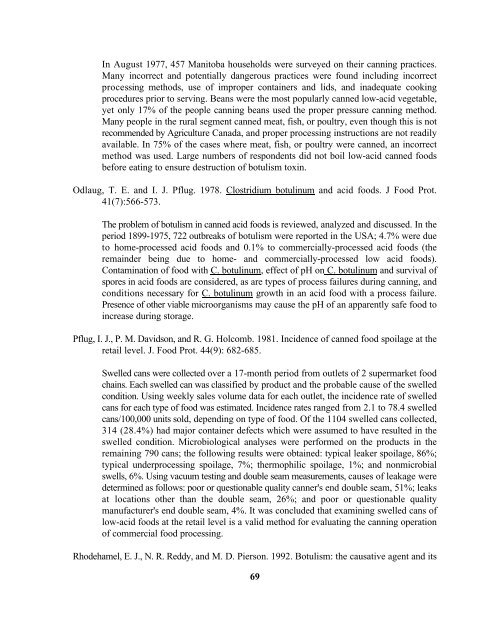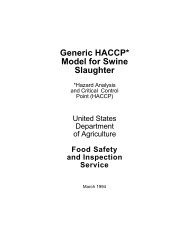Generic HACCP Model for Thermally Processed Commercial
Generic HACCP Model for Thermally Processed Commercial
Generic HACCP Model for Thermally Processed Commercial
Create successful ePaper yourself
Turn your PDF publications into a flip-book with our unique Google optimized e-Paper software.
In August 1977, 457 Manitoba households were surveyed on their canning practices.<br />
Many incorrect and potentially dangerous practices were found including incorrect<br />
processing methods, use of improper containers and lids, and inadequate cooking<br />
procedures prior to serving. Beans were the most popularly canned low-acid vegetable,<br />
yet only 17% of the people canning beans used the proper pressure canning method.<br />
Many people in the rural segment canned meat, fish, or poultry, even though this is not<br />
recommended by Agriculture Canada, and proper processing instructions are not readily<br />
available. In 75% of the cases where meat, fish, or poultry were canned, an incorrect<br />
method was used. Large numbers of respondents did not boil low-acid canned foods<br />
be<strong>for</strong>e eating to ensure destruction of botulism toxin.<br />
Odlaug, T. E. and I. J. Pflug. 1978. Clostridium botulinum and acid foods. J Food Prot.<br />
41(7):566-573.<br />
The problem of botulism in canned acid foods is reviewed, analyzed and discussed. In the<br />
period 1899-1975, 722 outbreaks of botulism were reported in the USA; 4.7% were due<br />
to home-processed acid foods and 0.1% to commercially-processed acid foods (the<br />
remainder being due to home- and commercially-processed low acid foods).<br />
Contamination of food with C. botulinum, effect of pH on C. botulinum and survival of<br />
spores in acid foods are considered, as are types of process failures during canning, and<br />
conditions necessary <strong>for</strong> C. botulinum growth in an acid food with a process failure.<br />
Presence of other viable microorganisms may cause the pH of an apparently safe food to<br />
increase during storage.<br />
Pflug, I. J., P. M. Davidson, and R. G. Holcomb. 1981. Incidence of canned food spoilage at the<br />
retail level. J. Food Prot. 44(9): 682-685.<br />
Swelled cans were collected over a 17-month period from outlets of 2 supermarket food<br />
chains. Each swelled can was classified by product and the probable cause of the swelled<br />
condition. Using weekly sales volume data <strong>for</strong> each outlet, the incidence rate of swelled<br />
cans <strong>for</strong> each type of food was estimated. Incidence rates ranged from 2.1 to 78.4 swelled<br />
cans/100,000 units sold, depending on type of food. Of the 1104 swelled cans collected,<br />
314 (28.4%) had major container defects which were assumed to have resulted in the<br />
swelled condition. Microbiological analyses were per<strong>for</strong>med on the products in the<br />
remaining 790 cans; the following results were obtained: typical leaker spoilage, 86%;<br />
typical underprocessing spoilage, 7%; thermophilic spoilage, 1%; and nonmicrobial<br />
swells, 6%. Using vacuum testing and double seam measurements, causes of leakage were<br />
determined as follows: poor or questionable quality canner's end double seam, 51%; leaks<br />
at locations other than the double seam, 26%; and poor or questionable quality<br />
manufacturer's end double seam, 4%. It was concluded that examining swelled cans of<br />
low-acid foods at the retail level is a valid method <strong>for</strong> evaluating the canning operation<br />
of commercial food processing.<br />
Rhodehamel, E. J., N. R. Reddy, and M. D. Pierson. 1992. Botulism: the causative agent and its<br />
69



